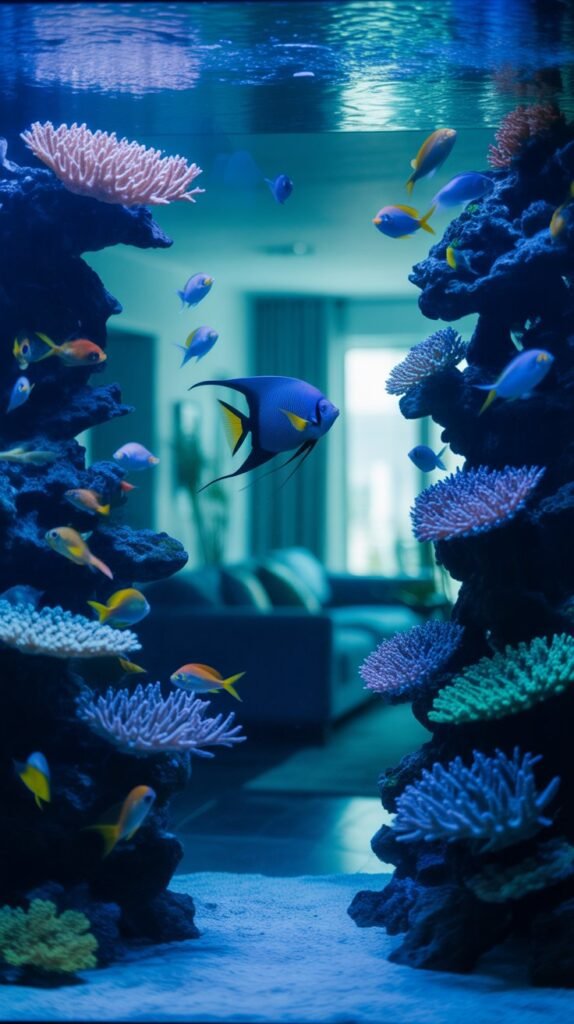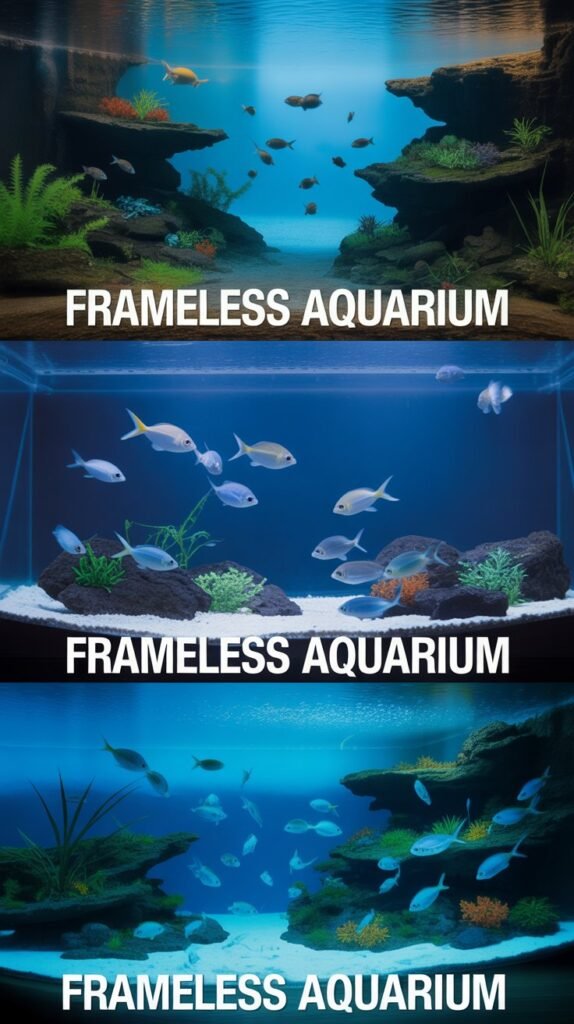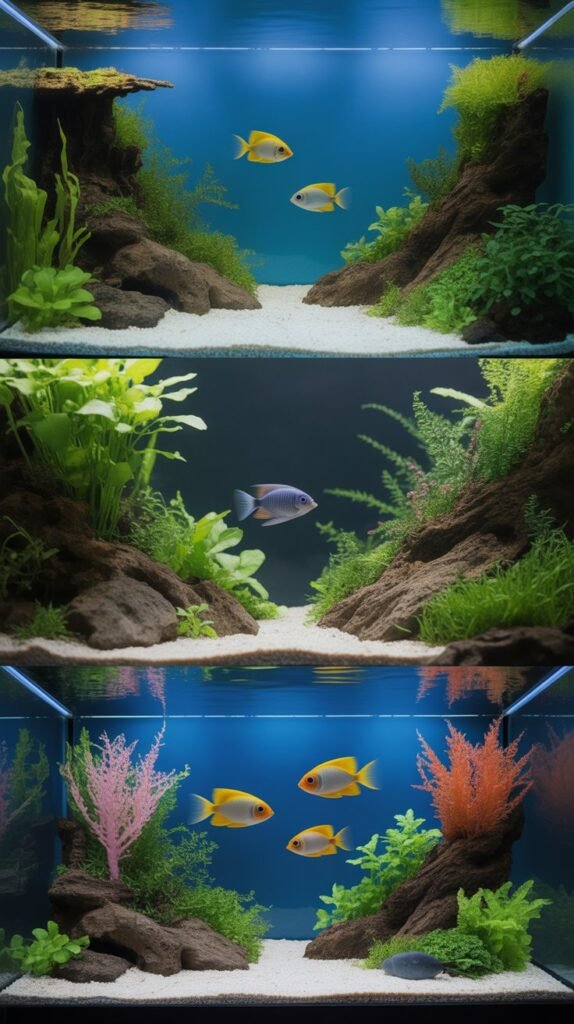Aquariums have long been admired not only for their ability to house fish and aquatic plants but also for their role as a living piece of décor. In recent years, the demand for sleek, minimalistic designs has brought frameless aquariums into the spotlight. Known for their clear, seamless appearance, frameless aquariums have become a favorite among aquascaping enthusiasts, designers, and aquarium hobbyists alike.
In this detailed guide, we’ll explore everything you need to know about frameless aquariums, including their benefits, drawbacks, setup process, maintenance, and ideal species to keep. By the end of this article, you’ll understand why frameless tanks are considered the future of modern aquarium keeping.
What is a Frameless Aquarium?
A frameless aquarium is an aquarium built without the traditional plastic or metal frame around its edges. Instead, the glass panels are seamlessly joined with high-strength silicone, giving the aquarium a clean, unobstructed appearance.

Most frameless aquariums are constructed using low-iron glass (also known as ultra-clear, starfire, or crystal glass) that eliminates the green tint present in standard aquariums. This ensures a true-to-life viewing experience where fish, plants, and corals appear vibrant and natural.
Frameless aquariums are often associated with luxury and modern aesthetics, making them popular in homes, offices, restaurants, and professional aquascaping competitions.
Frameless Aquarium vs. Traditional Aquarium
If you’re wondering how a frameless aquarium compares with a standard framed aquarium, here’s a quick breakdown:
| Feature | Frameless Aquarium | Traditional Aquarium |
|---|---|---|
| Appearance | Minimal, elegant, seamless | Framed with plastic/metal rims |
| Glass Quality | Usually low-iron for crystal clarity | Standard glass with greenish tint |
| View | Unobstructed from all angles | Frame slightly obstructs view |
| Durability | Relies on thick glass and strong silicone | Extra support from rim/frame |
| Price | Higher (premium product) | More affordable |
| Best Use | Aquascaping, modern interior design, luxury setups | Beginner tanks, budget setups |
Benefits of a Frameless Aquarium
Frameless aquariums are not just about aesthetics—they bring several practical advantages too. Here are some key benefits:
1. Modern, Elegant Design
The biggest appeal of frameless aquariums is their sleek and contemporary look. Without frames, the tank looks like a glass cube of living art, blending perfectly with modern interiors.
2. Unobstructed Viewing
Unlike framed aquariums, frameless tanks provide clear, edge-to-edge visibility, making it feel like your fish and aquascape are floating in space.
3. Better Aquascaping Potential
Aquascapers prefer frameless aquariums because they highlight plants, rocks, and driftwood layouts without distraction. Every detail of the aquascape becomes more prominent.
4. True Colors
The use of low-iron glass eliminates the green hue of normal glass, offering true, vibrant colors of fish, plants, and corals.
5. Premium Appeal
Frameless aquariums are often associated with luxury. They don’t just house fish—they act as centerpieces in living rooms, offices, and commercial spaces.
Drawbacks of a Frameless Aquarium

While frameless aquariums are stunning, they also have some downsides:
- Higher Cost – Due to better glass and craftsmanship, frameless tanks are pricier.
- Fragile Edges – Exposed edges are more prone to chips or scratches.
- No Spill Protection – Without a raised rim, water splashes and spills are more common.
- Heavier Glass – Frameless tanks often require thicker glass for structural strength, making them heavier than standard tanks.
- Less Forgiving of Mistakes – A perfectly level stand is crucial; uneven surfaces can stress the glass.
Types of Frameless Aquariums
Frameless aquariums come in different sizes and shapes, catering to various aquarium-keeping styles:
- Nano Frameless Aquariums – Ranging from 2 to 10 gallons, these are compact, ideal for desktops or small spaces.
- Medium-Sized Frameless Tanks – Typically 20 to 40 gallons, perfect for aquascaping beginners or hobbyists.
- Large Frameless Aquariums – 55 gallons or more, often used as statement pieces in living rooms or offices.
- Cube Frameless Aquariums – A cube-shaped tank, perfect for minimal aquascapes or shrimp colonies.
- Custom Frameless Aquariums – Built-to-order tanks for aquarists with unique size and design requirements.
Setting Up a Frameless Aquarium
A frameless aquarium requires more precision during setup compared to traditional tanks. Here’s a step-by-step guide:
Step 1: Choose the Right Stand
Frameless tanks require a flat, level, and sturdy stand. Unlike framed tanks, there is no rim to absorb uneven pressure, so any imbalance can lead to cracks. Many aquarists also use foam leveling mats beneath the aquarium for added safety.
Step 2: Plan Your Aquascape
Since frameless tanks highlight every detail, carefully plan your aquascaping layout. Use design principles like the rule of thirds or golden ratio for balance and aesthetics.
Step 3: Install Equipment
- Filter: Canister filters and hang-on-back filters work best to keep equipment discreet.
- Heater: Use a reliable submersible heater.
- Lighting: Frameless aquariums benefit from high-quality LED aquarium lights that promote plant growth and enhance visual appeal.
- CO2 System: For planted tanks, a CO2 injection system ensures lush plant growth.
Step 4: Add Substrate and Hardscape
Use nutrient-rich substrate for planted tanks or sand/gravel for fish-only setups. Arrange your driftwood, rocks, and other hardscape elements carefully before adding water.
Step 5: Add Plants and Fill Water
Plant live aquatic plants, then gently fill the aquarium with dechlorinated water to avoid disturbing the aquascape.
Step 6: Cycle the Tank
Allow the aquarium to cycle for 4–6 weeks to build up beneficial bacteria before introducing fish.
Step 7: Introduce Fish and Invertebrates
Once the cycle is complete, gradually add fish, shrimp, or snails. Avoid overstocking in the beginning.
Maintenance of Frameless Aquariums

Proper maintenance ensures the longevity of both your aquarium and its inhabitants:
- Weekly Water Changes – Replace 20–30% of the water weekly.
- Glass Cleaning – Frameless aquariums show smudges easily, so use aquarium-safe scrapers or microfiber cloths.
- Check Water Parameters – Regularly test for pH, ammonia, nitrites, and nitrates.
- Filter Maintenance – Rinse filter media every 2–4 weeks to maintain efficiency.
- Trim Plants – Keep aquascaping neat by trimming and replanting overgrown stems.
Best Fish for Frameless Aquariums
The minimalist, elegant nature of frameless aquariums makes them perfect for showcasing colorful or schooling fish. Popular options include:
- Nano Fish – Guppies, Endlers, Betta fish, Chili Rasboras
- Schooling Fish – Neon Tetras, Cardinal Tetras, Rummy Nose Tetras
- Peaceful Community Fish – Dwarf Gouramis, Mollies, Platies
- Shrimp and Snails – Cherry Shrimp, Amano Shrimp, Nerite Snails
- Saltwater Options – Clownfish, Gobies, Damsels (for marine setups)
Tips for Buying a Frameless Aquarium
When shopping for a frameless tank, keep these tips in mind:
- Check Glass Quality – Choose low-iron glass for the clearest visibility.
- Inspect Silicone Work – Joints should be clean, even, and bubble-free.
- Go for Reputable Brands – Trusted manufacturers ensure durability and safety.
- Match the Stand – Always use a stand designed for frameless aquariums.
- Choose the Right Size – Nano tanks are great for beginners, while large frameless tanks are best for experienced aquarists.
Frameless Aquarium for Freshwater vs. Saltwater
Frameless aquariums work equally well for both freshwater and saltwater setups:
- Freshwater: Ideal for aquascaping with plants, driftwood, and small fish species.
- Saltwater: Frameless reef tanks are stunning, showcasing corals and marine fish with unmatched clarity.
However, saltwater setups may require more maintenance and specialized equipment like protein skimmers.
Conclusion
A frameless aquarium is more than just a tank—it’s a work of art that combines modern design with the beauty of aquatic life. With their minimalistic look, crystal-clear glass, and unobstructed viewing, frameless tanks are perfect for aquascaping enthusiasts, interior decorators, and hobbyists who want to take their aquarium to the next level.
While they do require careful setup, higher investment, and consistent maintenance, the results are breathtaking. Whether you’re designing a lush planted scape, a vibrant reef aquarium, or a simple nano tank, a frameless aquarium can transform your space into a living masterpiece.
FAQs About Frameless Aquariums
Q1: Are frameless aquariums safe?
Yes, frameless aquariums are safe when built with high-quality glass and silicone. The key is to use a perfectly level stand to avoid pressure points.
Q2: Do frameless aquariums leak easily?
Not if properly manufactured. A frameless aquarium with strong silicone seals is just as durable as a rimmed tank.
Q3: Can beginners use frameless aquariums?
Yes, beginners can use frameless tanks, especially nano sizes. However, they require careful handling and a bit more investment than framed tanks.
Q4: Do frameless tanks need a lid?
Many frameless aquariums are open-top, but glass lids are available to prevent fish from jumping and reduce evaporation.
Q5: Are frameless aquariums expensive?
Yes, they are generally more expensive because they use thicker, low-iron glass and require precision craftsmanship.
Q6: What’s the difference between frameless and rimless aquariums?
Both terms are often used interchangeably. However, some aquarists use “rimless” to describe tanks without a top rim but with bottom support, while “frameless” typically means no frame at all.
Q7: Can I use a frameless aquarium for saltwater?
Absolutely. Frameless tanks are excellent for both freshwater aquascapes and saltwater reef tanks.

